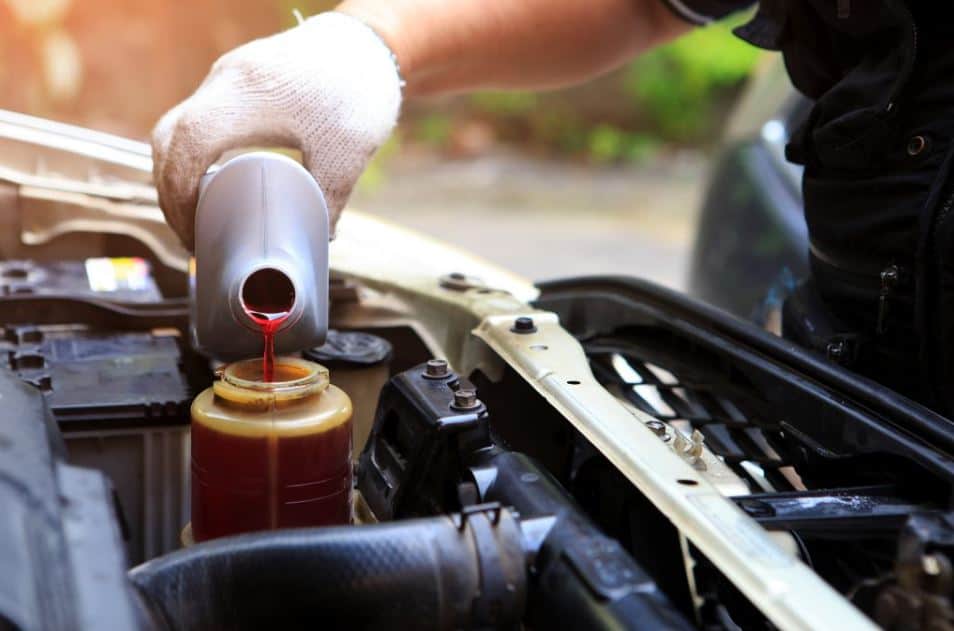Have you noticed it becoming harder and harder to turn the steering wheel?
I have experienced this with my car previously. When that occurred, turning the steering wheel required greater effort. Every time I drove, it seemed like my arms were working out. It turned out that the power steering fluid in my automobile was leaking.
You should read my tutorial if your vehicle is dripping power steering fluid. Let us take a closer look at this problem and what you may do to resolve it.

What Is Power Steering?
Driving an older car, possibly one from the 1990s may have made you aware of how difficult it is to turn. Turning the steering wheel in a contemporary car is simple and comfortable. Modern cars come with improved power steering.
Old cars do feature hydraulic pump assemblies for power steering. The power steering fluid may apply force on the steering assembly thanks to this assembly. Although it makes steering more bearable, it requires greater physical effort, particularly when making tight bends at low speeds.
In contemporary vehicles, the steering assembly is connected to an electronic motor and control module. The second one determines the vehicle’s speed and turning speed. The computation is used to regulate the power steering fluid’s flow.
Power steering not only makes steering easier but also reduces road shocks and speeds up vehicle responsiveness.
What Leads to a Leak in the Power Steering Fluid?
You have an issue if the power steering fluid starts to leak. What initially causes a leak to happen? These typical reasons are listed.
Incompatible Fluid
The power steering fluid must be changed every four years or 50,000 miles. It is feasible to employ an incompatible fluid, however. Either the fluid is too thin or too thick. Additionally, it can lack the crucial chemicals that counteract wear. See the owner’s handbook for your car to determine which fluid type is appropriate.
Inquire with a technician about synthetic power steering fluid as well. These special formulas maintain the fluid’s consistency even when the temperature changes. Find out whether your car model is compatible with synthetic fluid.
Worn Power Steering Hose
The power hose ages with time due to corrosion, humidity, and heat. The hose’s valve or O-ring often experiences wear and strain. When these parts deteriorate, little pieces come away and enter the fluid. This breakup severely diminishes the fluid’s effectiveness.
Steering Pump Damage
The power steering fluid is injected into the gearbox by the steering pump. Pressure is created to make the pump operate. A leak may result from the gasket becoming loose due to excessive pressure. If the steering pump is the problem, you could hear a whining sound that becomes louder as you accelerate.
Rough Driving Conditions
Driving in difficult circumstances, including off-road terrain and roads with potholes, may strain the steering system, pump, and belts. If you must drive in these circumstances, it is preferable to swap to an SUV or all-terrain vehicle. These cars have stronger suspension systems that can handle difficult terrain.
Power steering fluid leak signs
If your automobile has a power steering fluid leak, it will give you warning signs. Keep an eye out for these indicators.
- Steering difficulty: This is the most obvious symptom since power steering is designed to simplify steering. To shift the steering wheel, a greater force will be needed.
- Fluid puddles: Does the ground where you park your automobile have any fluid pools? It is most likely a power-guiding fluid leak if the fluid is reddish.
- Ignition noise: When you turn the key in the ignition, you may hear a squealing sound.
- Delayed steering reaction: When turning quickly or doing U-turns, there may be a lag in the steering response.
- Whining noise: Especially while turning, you could hear a whining or whirring sound.
- Fluid below fill line: The reservoir’s power steering fluid is significantly below the fill level.
A Power Steering Fluid Leak: How to Stop It
The best action is to take your car to a mechanic if you experience any of the symptoms above. If you are familiar with working beneath a car’s hood, you may be able to fix the leak on your own. Perform a power steering fluid cleanse as one potential fix. This flush removes pollutants from the system, and wear to the hose, and related components are avoided.
If a cracked steering pump casing is the problem, you may replace it for a reasonable price. Some cases have separate internal seals that can be changed. Additionally, a fractured reservoir is conceivable; you will need to replace it in this case.
How to Stop a Leak in the Power Steering Fluid
Your driving style can cause a leak. By not rotating the steering wheel all the way, you may help the power steering system last longer.
The pump and lines get strained until the stopper is reached when you keep turning the wheel. When you hit the stopper, immediately turn the wheel back a little if you have to turn it all the way, such as when doing a U-turn. Avoid maintaining pressure on the stopper with the steering wheel.
Power Steering Leak Stopper
You should question the mechanic about using power steering leak stoppers when you bring your automobile for repair. This stopper is a material that covers the O-rings and other areas where leaks often happen once again.
Serpentine Belt Inspection
The serpentine belt should be examined as part of routine maintenance. The steering pump is put under great pressure and may become completely unusable if the belt slides or breaks. Every 90,000 miles, the serpentine belt has to be changed.
Conclusion
You must immediately handle a power steering fluid leak since it is a major annoyance. The issue does not resolve itself. Ignoring it will only result in later, more serious issues.
Do something, whether it be a DIY remedy or a trip to the mechanic. The consequences extend well beyond a firmer steering wheel.

